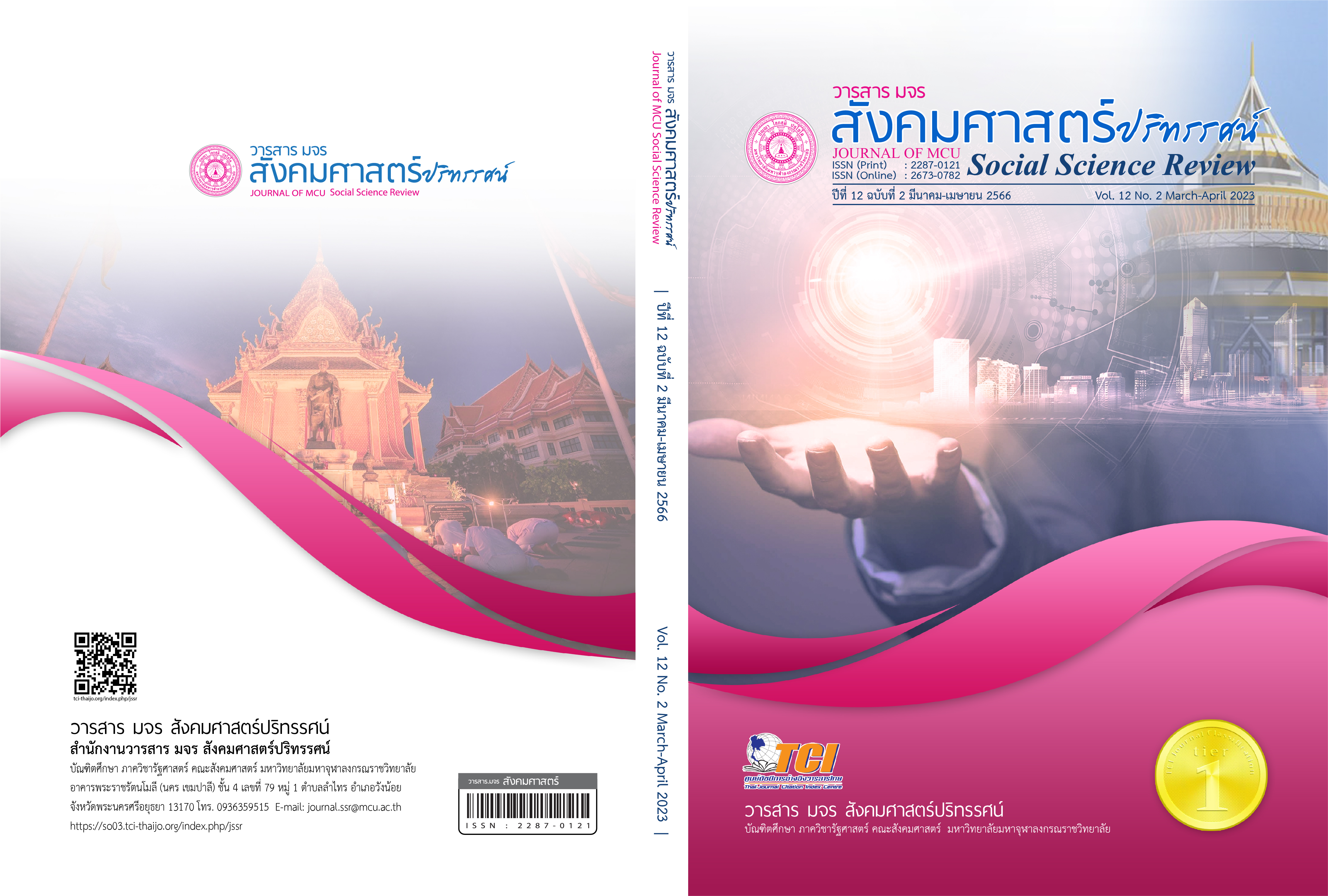กลยุทธ์การดำเนินการระบบงานประกันคุณภาพภายใน สถานศึกษาขั้นพื้นฐานในยุคดิจิทัล
คำสำคัญ:
กลยุทธ์, งานประกันคุณภาพภายใน, สถานศึกษาขั้นพื้นฐานบทคัดย่อ
บทความวิจัยนี้มีวัตถุประสงค์เพื่อนำเสนอกลยุทธ์การดำเนินการระบบงานประกันคุณภาพภายในสถานศึกษาขั้นพื้นฐานในยุคดิจิทัล เป็นการวิจัยรูปแบบผสานวิธี มี 4 ระยะ ดังนี้ 1) ศึกษาสภาพปัจจุบันและความต้องการการดำเนินงานประกันคุณภาพ ตัวอย่าง 168 คน 2) สร้างกลยุทธ์โดย ผู้เชี่ยวชาญ 11 คน 3) ทดลองใช้กลยุทธ์กับกลุ่มตัวอย่าง 20 คน และ 4) ประเมินกลยุทธ์โดยผู้ทรงคุณวุฒิ 21 คน เครื่องมือที่ใช้ ได้แก่ แบบสอบถาม แบบสัมภาษณ์ แบบบันทึก และแบบประเมินกลยุทธ์ สถิติที่ใช้ ได้แก่ ร้อยละ ค่าเฉลี่ย
ส่วนเบี่ยงเบนมาตรฐาน และการวิเคราะห์เนื้อหา
ผลการวิจัยพบว่า กลยุทธ์การดำเนินการระบบงานประกันคุณภาพภายในสถานศึกษาขั้นพื้นฐานในยุคดิจิทัล มี 4 องค์ประกอบ ได้แก่ 1) วิสัยทัศน์ 2) พันธกิจ 3) เป้าประสงค์ 4) กลยุทธ์ ซึ่งประกอบด้วย 5 กลยุทธ์หลัก ดังนี้ 1) กลยุทธ์พัฒนาคุณภาพการศึกษาด้วยเทคโนโลยีที่ทันสมัย ประกอบด้วย 2 ตัวชี้วัด 9 แนวทางดำเนินการ 2) กลยุทธ์พัฒนาบุคลากรในการใช้เทคโนโลยีอย่างมืออาชีพ ประกอบด้วย 2 ตัวชี้วัด 8 แนวทางดำเนินการ 3) กลยุทธ์สร้างวัฒนธรรมองค์กรที่ดีในการดำเนินการประกันคุณภาพการศึกษา ประกอบด้วย 1 ตัวชี้วัด 7 แนวทางดำเนินการ 4) กลยุทธ์สนับสนุนการใช้สื่อเทคโนโลยีในการดำเนินงานอย่างมีประสิทธิภาพ ประกอบด้วย 2 ตัวชี้วัด 10 แนวทางดำเนินการ 5) กลยุทธ์สร้างภาคีเครือข่ายการระดมทรัพยากรการศึกษา ประกอบด้วย 2 ตัวชี้วัด 7 แนวทางดำเนินการ ผลการประเมินกลยุทธ์อยู่ในระดับมากที่สุด
เอกสารอ้างอิง
จันทร เพชรบูรณ์. (2555). กลยุทธ์การพัฒนาระบบประกันคุณภาพภายในสถานศึกษาขั้นพื้นฐาน สังกัดสำนักงานเขตพื้นที่การศึกษาประถมศึกษากำแพงเพชรเขต 1 และเขต 2 (วิทยานิพนธ์ปรัชญาดุษฎีบัณฑิต). กำแพงเพชร: มหาวิทยาลัยราชภัฏกำแพงเพชร.
บุญชม ศรีสะอาด. (2560). การวิจัยเบื้องต้น (พิมพ์ครั้งที่ 10). กรุงเทพฯ: สุวีริยาสาส์น.
มาลัย วงศ์ฤทัยวัฒนา. (2556). แนวทางการบริหารโรงเรียนขนาดเล็กยุคดิจิทัลสู่ความเป็นเลิศของสำนักงานเขตพื้นที่การศึกษาประถมศึกษาชัยนาท. วารสารวิจัยและพัฒนา วไลยอลงกรณ์ในพระบรมราชูปถัมภ์, 14(1), 24.
สาโรจน์ ขอจ่วนเตี๋ยว. (2557) กลยุทธ์การบริหารการประกันคุณภาพของวิทยาลัยเทคนิค สังกัดสำนักงาน คณะกรรมการการอาชีวศึกษา (วิทยานิพนธ์ปรัชญาดุษฎีบัณฑิต). กรุงเทพฯ: มหาวิทยาลัยศรีปทุม.
สมเกียรติ บุญสูงเนิน. (2560). กลยุทธ์การบริหารงานการประกันคุณภาพภายในสถานศึกษาที่มีประสิทธิภาพสังกัดสำนักงานเขตพื้นที่การศึกษาประถมศึกษาชัยภูมิ เขต 1.วารสารวิชาการธรรมทรรศน์, 17(3), 223-235.
สำนักงานเลขาธิการสภาการศึกษา. (2560). แผนการศึกษาแห่งชาติ พ.ศ. 2560 – 2579. สำนักทดสอบทางการศึกษา. (2561). แนวทางการประเมินคุณภาพตามมาตรฐานการศึกษาระดับปฐมวัย ระดับการศึกษาขั้นพื้นฐานและระดับการศึกษาขั้นพื้นฐานศูนย์การศึกษาพิเศษ กรุงเทพฯ: โรงพิมพ์ชุมนุมสหกรณ์การเกษตรแห่งประเทศไทย จํากัด.
อนิวัช แก้วจํานง. (2555). การจัดการเชิงกลยุทธ์ (พิมพ์ครั้งที่ 2). สงขลา: นําศิลป์โฆษณา.
Julian, R. H. (2006). Macroeconomic Studies in Higher Education. Dissertation Abstracts international.
ดาวน์โหลด
เผยแพร่แล้ว
รูปแบบการอ้างอิง
ฉบับ
ประเภทบทความ
สัญญาอนุญาต
ลิขสิทธิ์ (c) 2023 วารสาร มจร สังคมศาสตร์ปริทรรศน์

อนุญาตภายใต้เงื่อนไข Creative Commons Attribution-NonCommercial-NoDerivatives 4.0 International License.
เพื่อให้เป็นไปตามกฎหมายลิขสิทธิ์ ผู้นิพนธ์ทุกท่านต้องลงลายมือชื่อในแบบฟอร์มใบมอบลิขสิทธิ์บทความให้แก่วารสารฯ พร้อมกับบทความต้นฉบับที่ได้แก้ไขครั้งสุดท้าย นอกจากนี้ ผู้นิพนธ์ทุกท่านต้องยืนยันว่าบทความต้นฉบับที่ส่งมาตีพิมพ์นั้น ได้ส่งมาตีพิมพ์เฉพาะในวารสาร มจร สังคมศาสตร์ปริทรรศน์ เพียงแห่งเดียวเท่านั้น หากมีการใช้ภาพหรือตารางหรือเนื้อหาอื่นๆ ของผู้นิพนธ์อื่นที่ปรากฏในสิ่งตีพิมพ์อื่นมาแล้ว ผู้นิพนธ์ต้องขออนุญาตเจ้าของลิขสิทธิ์ก่อน พร้อมทั้งแสดงหนังสือที่ได้รับการยินยอมต่อบรรณาธิการ ก่อนที่บทความจะได้รับการตีพิมพ์ หากไม่เป็นไปตามข้อกำหนดเบื้องต้น ทางวารสารจะถอดบทความของท่านออกโดยไม่มีข้อยกเว้นใดๆ ทั้งสิ้น





